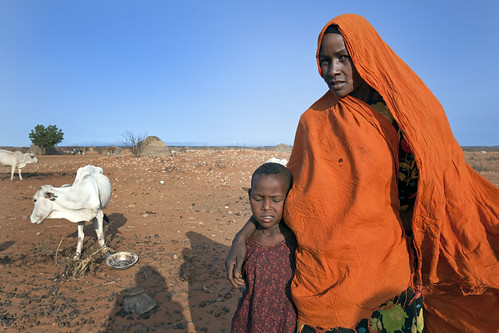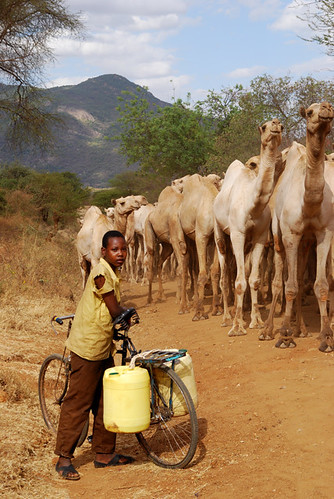Pastoralists from Marsabit, in Kenya’s remote northern drylands, play a game crafted by ILRI scientists to simulate livestock losses that could occur due to drought, in which the local herding communities are educated about how index-based livestock insurance works (image credit: ILRI).
As livestock deaths mount, a small group of herders in Kenya’s Marsabit District is first to benefit from program that tracks forage conditions via satellite.
In the midst of a drought-induced food crisis affecting millions in the Horn of Africa, an innovative insurance program for poor livestock keepers is making its first payouts today, providing compensation for some 650 insured herders in northern Kenya’s vast Marsabit District who have lost up to a third of their animals.
Known as index-based livestock insurance, or IBLI, payouts are triggered when satellite images show that grazing lands in the region have deteriorated to the point that herders are expected to be losing more than 15% of their herd. The current readings for which indemnities are now being paid show that between 18 and 33% of livestock have been lost to drought this season.
‘It’s terrible that we are seeing this level of loss, but gratifying that the policies are doing what they are supposed to do, which is to help herders avert disaster when weather conditions dry up pasture lands and animals begin to perish,’ said Isaac Magina, head of agriculture insurance at UAP Insurance Ltd.
‘When you look at a 33% loss, that is a significant portion of the asset base of any business and it would be difficult to survive without insurance,’ added Magina.
The insurance project was developed in partnership by the Nairobi-based International Livestock Research Institute (ILRI), Cornell University and the Index Insurance Innovation Initiative program at the University of California at Davis. Commercial partners Equity Bank and UAP Insurance Ltd implement the program. The IBLI project is funded by the United States Agency for International Development, the European Union, the British Government, the World Bank, the Microinsurance Facility and the Global Index Insurance Facility.
The Marsabit District alone is home to some 86 thousand cattle and 2 million goats and sheep that generate millions of dollars in milk and other products and serve as the main source of sustenance and income. ILRI estimates that up to one-third of all livestock in the region have perished during the current drought.
In East Africa, an estimated 70 million people live in the drylands, and many of them are herders. In Kenya, the value of the pastoral livestock sector is estimated to be worth USD800 million. And the Intergovernmental Authority on Development in Eastern Africa, which takes a regional approach to combating drought in six countries of the Horn, estimates that over 90% of the meat consumed in East Africa comes from pastoral herds.
Under the terms of the policy, insured herders are compensated for any losses above 15%, with the 15% threshold acting as a sort of deductible. For example, a cattle herder who lives in an area with a livestock mortality rate of 33% receives a payout covering 18% of his or her animals. With cattle valued at about 15,000 Kenyan shillings (Ksh) per head (about USD150), an insurance policy covering 10 animals, or Kshs150,000 in cattle, would pay out at about Kshs27,000 (about USD270).
When the 15% deductible is factored in, compensation ranges from 3% in areas where the drought has been more moderate to 18% in the areas where herders were hit particularly hard. But in an indication of the severity of the drought, all of the areas where the policies were sold have exceeded the 15%mortality threshold that triggers a payout. Thus far, the policies cover about 1,100 animals—mostly cattle, but some goats and sheep and a few camels as well.
The payments are being dispatched in the middle of a humanitarian crisis endangering 12 million people in the Horn that is prompting a call for new ways to manage food security risks in East Africa’s arid drylands. For example, a recent report from ILRI has found that the pastoral approach to livestock production, in which herders make do with marginal lands by regularly moving their herds, could be very effective at averting weather-related food shortages. ILRI experts say that in arid and semi-arid regions, keeping livestock can be a more effective coping strategy than cultivating crops—if herders have options for reducing their vulnerability to drought.
‘Drought insurance is one important way to help livestock keepers maintain food security even in very harsh environments,’ said Andrew Mude, the IBLI project leader at ILRI. ‘Insurance is not by itself sufficient,’ he added, ‘But if it is accompanied by other risk-reducing strategies, such as better access to grazing lands and watering areas, then the pastoralist approach, which some people dismiss as a backward lifestyle of the past, emerges as a very effective way to meet future food needs.’
Mude said that it is too early to tell just how the payouts from the policies will affect food security and other welfare indicators. For example, it’s not yet clear how many herders will use the compensation to replace animals lost to the drought. But Mude said one major success thus far is that the livestock mortality index that is at the heart of the program appears to be working. The fatality rate predicted by the satellite assessments of forage loss is tracking very closely surveys of animal deaths on the ground.
That’s crucial because using freely available satellite images of pasture lands to accurately predict animal deaths overcomes a major barrier that has bedeviled past efforts to provide livestock insurance in poor regions: the prohibitively high costs and logistics of confirming animal deaths in herds that roam across vast distances in extremely remote areas.
‘This is all still a work in progress,’ said Jimmy Smith, director general of ILRI. ‘But the fact that our relatively inexpensive approach to estimating livestock deaths seems to be accurate could open the door to making livestock insurance widely available in many parts of Africa.’
Going forward, experts believe a key issue will be whether livestock insurance in East Africa would be commercially viable by itself or whether its ability to protect herders from the impact of prolonged drought might justify some level of financial support from governments or donors, as agricultural insurance programs in Western countries often do.
‘This is asset insurance for animals that are the centerpiece of livelihoods, providing a stream of income and nutrition for years and years,’ said Mude. ‘The investment in insurance=based asset safety nets protecting these herds could have a more cost-effective welfare impact over the longer term than other forms of response such a food and cash assistance.’
‘This insurance scheme is a great example of how partnerships with the private sector can lift people out of poverty and provide long-term solutions to food crises,’ said Andrew Mitchell, the British international development secretary.
‘To many farmers, losing their cattle means losing everything, as they are not just a source of income but are their only source of food. Support from Britain and others means that more than 600 herders in Northern Kenya can buy more cattle to replace those they have lost. This means they are better able to cope with this and future devastating droughts.’



